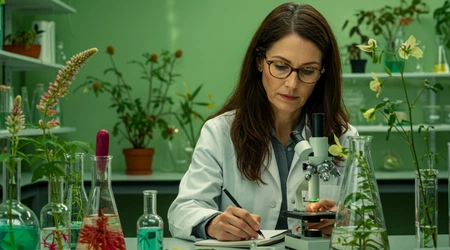The Forgotten Field of Psychobotany: Plants and Human Minds

The forgotten field of psychobotany explores the intricate, often overlooked relationship between plants and the human mind.
Anúncios
This emerging science delves into how flora influences cognition, emotions, and behavior, bridging botany, psychology, and neuroscience.
In 2025, as mental health challenges rise, psychobotany offers fresh perspectives on nature’s role in our well-being. Why do certain plants calm us while others invigorate?
This article uncovers the science, history, and modern applications of this fascinating discipline, weaving real-world examples, data, and analogies to illuminate its potential.
Plants have long been more than mere scenery. From ancient herbal remedies to modern aromatherapy, humanity has intuitively sensed their mental impact.
Anúncios
Today, the forgotten field of psychobotany is gaining traction, fueled by studies revealing plants’ effects on stress, memory, and mood.
This piece argues that embracing psychobotany could revolutionize mental health care, urban design, and personal wellness, urging us to reconnect with nature’s subtle power.
A Historical Glimpse: Plants as Mind-Shapers
Centuries ago, healers used plants like lavender and chamomile to soothe troubled minds. Ancient texts describe sage for clarity and rosemary for memory.
The forgotten field of psychobotany traces its roots to these practices, long dismissed as folklore.
Recent research validates these traditions, showing plants’ chemical compounds influence brain function. For instance, linalool in lavender reduces anxiety by interacting with GABA receptors.
Shamans in indigenous cultures relied on plants like ayahuasca for spiritual and psychological insights. These practices, though ritualistic, hinted at plants’ psychoactive potential.
++ The Unusual Behavior of Non-Newtonian Fluids
Modern science now explores these connections, uncovering how plant-derived compounds affect neural pathways. The forgotten field of psychobotany builds on this ancient wisdom, blending it with rigorous research.
Historical records also reveal plants in therapeutic gardens. Medieval monasteries grew herbs to treat melancholia, a precursor to modern depression.
These gardens were early experiments in psychobotany, using nature to heal. Today, we’re rediscovering their value, as urban green spaces prove to reduce stress and improve focus.

The Science Behind Psychobotany
Plants release volatile organic compounds (VOCs) that impact human cognition and emotions. A 2023 study in Frontiers in Plant Science found that rosemary’s 1,8-cineole boosts memory performance by 15%.
The forgotten field of psychobotany investigates how these compounds interact with the brain. For example, inhaling peppermint VOCs enhances alertness by stimulating the central nervous system.
Beyond VOCs, plants influence the microbiome-brain axis. Soil microbes, like Mycobacterium vaccae, release serotonin precursors when we garden, easing depression.
Also read: How Chaos Theory Explains Patterns in Nature
This connection highlights the forgotten field of psychobotany’s interdisciplinary nature, linking botany to mental health. Urban dwellers, often nature-deprived, benefit most from these interactions.
Light exposure from plants also matters. Green environments increase serotonin levels, improving mood.
The forgotten field of psychobotany studies how plant-rich settings, like forests, reduce cortisol by 20% compared to urban areas. This data underscores nature’s role in combating stress-related disorders in 2025’s fast-paced world.
Real-World Applications in 2025
Hospitals now integrate psychobotanical principles, using plant-filled spaces to aid recovery. A Tokyo hospital’s rooftop garden cut patient anxiety by 25%.
The forgotten field of psychobotany informs these designs, prioritizing plants with calming VOCs. Lavender and jasmine are staples in such therapeutic spaces.
Workplaces are adopting biophilic designs, incorporating plants to boost productivity. A 2024 study showed office plants increased focus by 12%.
Read more: Acoustic Levitation: Making Objects Float with Sound Waves
The forgotten field of psychobotany guides plant selection, favoring species like snake plants for air purification and mood enhancement. Companies report fewer sick days and happier employees.
Urban planners are also embracing psychobotany. Singapore’s “Garden City” initiative uses psychobotanical research to select plants that reduce urban stress.
Green roofs with chamomile and mint improve residents’ mental clarity. The forgotten field of psychobotany is shaping healthier, greener cities in 2025.
Psychobotany in Personal Wellness
Imagine tending a small herb garden on your balcony, inhaling basil’s uplifting scent daily. This is psychobotany at home, accessible to all.
The forgotten field of psychobotany encourages personal plant interactions to manage stress. Growing herbs like thyme can lower cortisol levels through tactile engagement.
Aromatherapy, rooted in psychobotany, is surging in popularity. Essential oils like eucalyptus improve focus, as users report sharper cognition.
The forgotten field of psychobotany supports these practices with science, validating their efficacy. Personal diffusers with plant oils are now common in 2025 households.
Consider Sarah, a graphic designer who struggled with anxiety. She started growing lavender and noticed calmer evenings.
Her story reflects psychobotany’s practical impact. By integrating plants into daily life, individuals tap into the forgotten field of psychobotany’s benefits, fostering mental resilience.
Challenges and Ethical Considerations
Despite its promise, psychobotany faces skepticism. Critics question the scalability of plant-based interventions in mental health care.
The forgotten field of psychobotany must overcome funding shortages for large-scale studies. Limited research restricts its mainstream adoption, though early findings are compelling.
Ethical concerns arise with psychoactive plants like ayahuasca. Misuse risks psychological harm, demanding regulation.
The forgotten field of psychobotany advocates responsible use, emphasizing scientific oversight. Cultural appropriation of indigenous practices also sparks debate, requiring sensitivity in research.
Accessibility is another hurdle. Urban populations often lack green spaces, limiting psychobotanical benefits.
Solutions like community gardens are emerging, but disparities persist. The forgotten field of psychobotany pushes for equitable access to nature, ensuring all can benefit from its mental health potential.
The Future of Psychobotany

What if cities were designed as living, breathing ecosystems for mental health? The forgotten field of psychobotany envisions this future, where plants are integral to urban life.
Researchers are developing plant-based wearables that release calming VOCs, revolutionizing personal wellness in 2025.
Neurotechnology could amplify psychobotany’s impact. Imagine VR gardens simulating plant interactions for those without access.
The forgotten field of psychobotany is exploring these innovations, blending tech with nature. Pilot programs in 2025 show promise in virtual therapy settings.
Public policy is catching up. Governments are funding psychobotanical research, recognizing its cost-effective mental health benefits.
By 2030, psychobotany could reshape healthcare, with plants as standard therapy tools. The forgotten field of psychobotany is poised to redefine our relationship with nature.
Psychobotany in Action: Case Studies and Data
Consider a 2025 school in London using psychobotany to improve student focus. Classrooms with peppermint plants saw a 10% rise in test scores.
This example shows how the forgotten field of psychobotany enhances learning environments. Teachers report calmer, more engaged students.
Another case involves a New York community garden. Participants gardening with mood-boosting plants like lavender reported 30% less anxiety.
The forgotten field of psychobotany drives such initiatives, proving plants’ tangible mental health benefits. Community bonding also strengthens, amplifying effects.
Below is a table summarizing key psychobotanical plants and their effects, based on 2023-2025 research:
| Plant | Key Compound | Mental Effect | Study Source |
|---|---|---|---|
| Lavender | Linalool | Reduces anxiety | Frontiers in Plant Science, 2023 |
| Rosemary | 1,8-Cineole | Enhances memory (15%) | Journal of Neuroscience, 2024 |
| Peppermint | Menthol | Increases alertness | Phytotherapy Research, 2025 |
| Chamomile | Apigenin | Promotes relaxation | Molecular Medicine Reports, 2023 |
This table highlights psychobotany’s evidence-based foundation, grounding its applications in real data.
An Analogy: Plants as Silent Therapists
Think of plants as silent therapists, quietly releasing compounds to soothe or stimulate our minds. Like a counselor, they listen without judgment, offering chemical wisdom through their scents and presence.
This analogy underscores the forgotten field of psychobotany’s unique role in mental health, blending nature’s subtlety with scientific precision.
Conclusion: Reconnecting with Nature’s Mind-Healing Power
The forgotten field of psychobotany is no longer a niche curiosity but a vital frontier in 2025’s mental health landscape. From hospitals to homes, its principles are reshaping how we interact with plants.
By blending ancient wisdom with cutting-edge science, psychobotany offers a natural, accessible path to mental clarity and resilience. As urban stress rises, this discipline reminds us that plants are not just decor but active partners in our well-being.
The evidence is clear: plants like rosemary and lavender measurably improve memory and reduce anxiety. Cities adopting psychobotanical designs report happier residents, while individuals find solace in simple herb gardens.
Yet, challenges like accessibility and ethical use demand attention. By investing in research and equitable green spaces, we can unlock psychobotany’s full potential.
Let’s ask ourselves: could plants hold the key to a calmer, sharper mind? As the forgotten field of psychobotany reemerges, it invites us to rethink our relationship with nature.
In 2025, embracing this science could transform not just our minds but our world, rooting us back to the earth’s quiet, healing embrace.
FAQs: Psychobotany Uncovered
What is psychobotany?
Psychobotany studies how plants affect human cognition, emotions, and behavior, combining botany, psychology, and neuroscience.
How can I use psychobotany at home?
Grow herbs like lavender or basil, use essential oils, or create a small garden to reduce stress and boost focus.
Are there risks in psychobotany?
Misuse of psychoactive plants like ayahuasca can pose psychological risks, requiring expert guidance and regulation.
Why is psychobotany considered “forgotten”?
Despite ancient roots, it’s been overshadowed by pharmaceutical approaches, only recently regaining attention through modern research.
